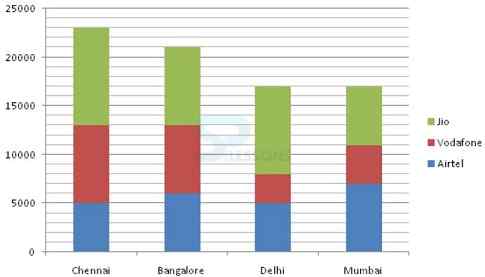 Introduction
Introduction
What is Quantitative Aptitude test?
Quantitative Aptitude is one of the prominent competitive aptitude subjects which evaluates numerical ability and problem solving skills of candidates. This test forms the major part of a number of important entrance and recruitment exams for different fields. The Quantitative Aptitude section primarily has questions related to the Simplification, Numbering Series, and Compound Interest, etc.
A candidate with quantitative aptitude knowledge will be in a better position to analyse and make sense of the given data. Quantitative Aptitude knowledge is an important measure for a prospective business executive's abilities.
The article IBPS Clerk Prelims Numerical Ability Quiz 7 provides Quantitative Aptitude questions with answers useful to the candidates preparing for Competitive exams, Entrance exams, Interviews etc.
 Quiz
Quiz
Directions(1–5): Study the following information carefully and answer the questions given below.
The given bar graph shows the number of person who uses the different networks in different cities.
1. What is the average of the difference between the number of Airtel users in Chennai and Mumbai and the difference between the number of Vodafone users in Delhi and Bangalore?- A. 2000
B. 3000
C. 4000
D. 5000
E. None of these
- A. 43%
B. 45%
C. 47%
D. 49%
E. 41%
- A. 5200
B. 5300
C. 5400
D. 5500
E. None of these
- A. 3 : 2
B. 4 : 3
C. 5 : 4
D. 6 : 5
E. None of these
- A. 1500
B. 2000
C. 3500
D. 3000
E. None of these
Directions(1–3): What value should come in the place of (?) in the following number series?
1. 4080, 3360, 2730, 2184, 1716, ?
- A. 1320
B. 1850
C. 1560
D. 1210
E. 1080
- A. 52
B. 48
C. 33
D. 28
E. 22
- A. 1528
B. 1236
C. 1328
D. 1124
E. 1456
- A. 0.75
B. 0.5
C. 0.25
D. 0.2
E. None of these
- A. [latex]\frac {9}{25}[/latex]
B. [latex]\frac {9}{50}[/latex]
C. [latex]\frac {18}{25}[/latex]
D. [latex]\frac {1}{25}[/latex]
E. None of these
1. A dealer marks price of all the goods at 30 % above the cost price and assumes that he will make a profit of 15 % if he offers a discount of 15%. Find what will be his actual profit on sales?
- A. 15%
B. 30%
C. 12.50%
D. 10.50%
E. None of these
- A. Rs. 20.36
B. Rs. 22.90
C. Rs. 25.89
D. Rs. 30.50
E. None of these
- A. 3.5 days
B. 5 days
C. 7.5 days
D. 12 days
E. None of these
- A. 22
B. 30
C. 37
D. 52
E. 80
- A. 10 : 3
B. 8 : 5
C. 9 : 4
D. 1 : 1
E. 4 : 4






